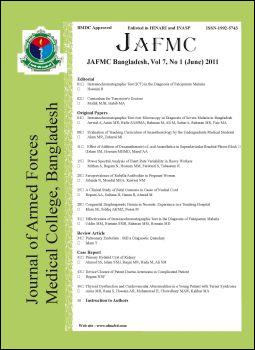Seroprevalence of Rubella Antibodies in Pregnant Women
DOI:
https://doi.org/10.3329/jafmc.v7i1.8621Keywords:
Rubella antibody, seroprevalence, pregnant womenAbstract
Introduction: Clinical or subclinical infection of rubella of pregnant mother gives rise to a handicap baby to the society. Some time affected baby born apparently normal, but subsequently expresses disability.
Objective: This study was carried out to see the seroprevalence of rubella antibodies in pregnant women.
Method: Single blood sample was taken from 134 pregnant women, 66 from 1st trimester, 36 from 2nd trimester and 32 from 3rd trimester. Blood samples were collected from different Out Patient Departments (OPD) of Combined Military Hospital (CMH) and Armed Forces Institute of Pathology (AFIP) over a period of six months. All the sera were examined by enzyme-linked immunosorbant assay (ELISA) for rubella specific Immunoglobulin M (IgM) and Immunoglobulin G (IgG).
Result: The over all prevalence of seropositivity for IgG was 84.33% indicating that they were immune for rubella infection and the rest 15.67% were susceptible for rubella infection. The seropositivity for IgM antibody was 0.75%, which was a single case found in 22 year old pregnant women in 3rd trimester and was 2nd gravida. The study demonstrated that 85.71% of the pregnant women between the ages of 15 to 20 years had rubella IgG, peaking at 87.80% in the age group 26-30 years and the seropositivity lower to 66.67% in the age group 31- 35 years.
Analysis of rubella specific IgG antibody among the different socio-economic group population in the present study, showed that seropositivity rate was much higher in lower (91.67%) socio-economic status group, 89.02% in middle status group and the difference was lower in upper (72.50%) socioeconomic status group and the difference was statistically significant (p<0.05). Higher (86.84%) incidence of seropositivity for IgG antibody was observed in women presenting with adverse pregnancy out comes than that the normal pregnancy (80.65%) out comes group.
Conclusion: The present study revealed that the substantial percentage of pregnant women were susceptible for rubella infection. The findings of this study will help to formulate a guideline for taking nation wide vaccination program.
Key words: Rubella antibody; seroprevalence; pregnant women
DOI: http://dx.doi.org/10.3329/jafmc.v7i1.8621
JAFMC Bangladesh. Vol 7, No 1 (June) 2011; 20-24
Downloads
259
659

